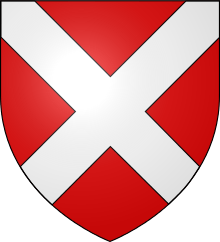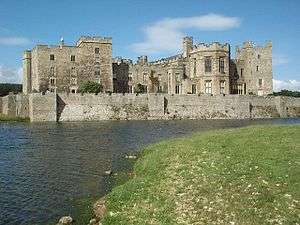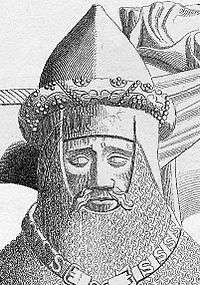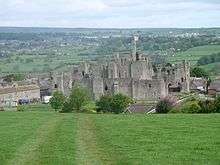Neville–Neville feud
| Neville familly feud | |||||||
|---|---|---|---|---|---|---|---|
| Part of Fifteenth-century England | |||||||
 Neville family coat of arms; this was worn by the senior branch, whilst Salisbury's- as a younger son- would have been differenced. | |||||||
| |||||||
| Belligerents | |||||||
| Senior branch of the House of Neville | Cadet branch of the House of Neville | ||||||
| Commanders and leaders | |||||||
| Ralph Neville, 1st Earl of Westmorland | Richard Neville, 5th Earl of Salisbury | ||||||
The Neville–Neville feud was an inheritance dispute which took place in the North of England during the early fifteenth century between two branches of the Neville family. The Earl of Westmorland disinherited his first wife's eldest son to the advantage of that by his second wife, and although this was later disputed by his dispossessed grandchild- legally and by force of arms- his 'younger' eldest son, the Earl of Salisbury, beat him decisively, partly due to his greater political connections.
Background and causes

Disputes over divided inheritances were not uncommon in later medieval England; apart from the dispute between branches of the Neville family, there were also violent feuds between the baronial families of Lisle and Talbot for similar reasons, and within the Mountford family, all of which, says Michael Hicks, were "large scale and high profile."[1] This was because inheritance by a second-wife's children was seen to be against the natural course of descent, and raised a question over the lower family's title which could be challenged.[2]
Ralph Neville, 1st Earl of Westmorland (c. 1364–1425) was married twice. His first wife, Margaret Stafford (daughter of the Earl of Stafford) died in 1396; with her, Ralph had two sons (the eldest John, and a namesake, Ralph). His next marriage (only five months after Margaret's death) was of far greater political significance:[3] it was to Joan Beaufort, the legitimized daughter of John of Gaunt,[4] and a cousin of the King, Richard II. In the words of Anthony Tuck, this marriage "was to have major consequences both for the Neville family and for the English nobility" in general, through the next century.[3] With Joan he was to have nine sons and five daughters.
Neville's new proximity to the royal family, and his loyalty to the crown during the crisis of July 1397 led to his elevation to the peerage as Earl of Westmorland. Almost immediately he began to enfeoff and convey a large chunk of the family patrimony away from the children of his first marriage in favour of those of his second. This resulted in- as A.J. Pollard called it- the "virtual disinheritance"[5] of the elder branch of the family in favour of that later to be headed by Richard Neville, 5th Earl of Salisbury.[3] This included the Honour of Penrith and Sheriff Hutton Castle, and by the time Ralph died in 1425 only the earldom itself (which, being entailed in the male line line, could not be given away) and some estates in Brancepeth, Northumberland, Lincolnshire, two Inns in London and Newcastle upon Tyne, Bywell Castle and property in Ripon went to Ralph's heir.[3] Everything else went to Richard, as his eldest son (born 1400) by Joan.[6]
Hicks has noted that this was done "quite legally,"[7] and it is possible that it was at the instigation of Joan, who Anthony Tuck has said was "more than capable of realizing this joint ambition on her own,"[5] and whom Pollard called "overbearing."[8] Charles Ross, on the other hand, has suggested that whilst it is indeed unlikely that the Earl of Westmorland had either "strong character or ability" this need not, he says, automatically mean that Joan was motivated by "deliberate malevolence" towards the elder branch, or that she was even particularly dominating. It was, he says, all the same "very much in his interests" to conform to her policies. He also suggests that perhaps the first Earl even recognised something "ineffective and colourless" in his son and grandson, which could account for him turning towards the stronger characters produced by his second wife.[9] A curious feature of the disinheritance is the behaviour of Ralph's eldest son, who was alive whilst it happened: not only does he not seem to have attempted to stop his father or prevent his son's disinheritance, but may even have assisted with some of the transfers.[10] Charles Ross wondered at this "complacency."[11]
Course of the dispute

Ralph Neville died in 1425;[3] his earldom descended to his grandson and namesake, Ralph, the second Earl,[6] whose father, John Neville had predeceased the first Earl of Westmorland, dying in France in 1420.[6] Neither of his sons were mentioned in the first Earl of Westmorland's Will;[12] provisions to them were described by Pollard as "niggardly."[10] His widow, Joan, immediately took possession of Middleham Castle Penrith Castle, and Sheriff Hutton for her son Richard.[13] Almost immediately Ralph came of age (24 February 1430)[14] he attempted to regain his estates; indeed, Pollard describes his whole life as being "dominated by his struggle to recover the greater part of his inheritance."[6] Westmorland claimed that his wealth had been cut by his grandfather's legacy from an expected annual income of around £2,600 to a mere £400,[6] and a modern historian has described him as being "poor in land as an earl as his father had been in early life as a baron."[15] Possibly rubbing salt into the wound, he was also required to pay Joan a third of a penny from his inheritance towards her dowry.[16]
However, Ralph's chief opponent, the Earl of Salisbury was a close and loyal servant of the Lancastrian crown; furthermore, Joan was still alive, and her brother was Cardinal Beaufort, one of the most powerful men in the country.[13] Salisbury also had three brothers who were peers of the realm (as Barons Fauconberg, Latimer, and Abergavenny), and another was later Bishop of Durham. The Cardinal was probably the most importanct player in ensuring that his nephew received the bulk of the inheritance,[17] not only due to his position on the King's council, but also because, in the interests of maintaining the peace, the council tended support its most powerful members—which after 1436, included Salisbury.[18] In the meantime, says J.R. Lander, there was "widespread violence in the north" alongside continual legal proceedings.[19] Whilst Michael Hicks has asserted that "force seldom determined title, although it often conferred possession,"[1] Lander has described Salisbury's strength as being "a combination of influence at the Lancastrian court and outright violence."[20]
The power of Salisbury and the Beauforts was repeatedly demonstrated: in 1430, Westmorland was forced into recognizance with Joan not to use force; a year later, when Salisbury departed for royal service in France, Ralph was again bound over not to attack her or her property; in 1435, he attempted to gain a copy of his father's first will, but was denied the opportunity by Joan's ally, Thomas Langley, Bishop of Durham, who may have destroyed it for her rather than allow it to aid Ralph in his lawsuit against her. In 1436, with Salsbury once again returning to France, Ralph was bound over on the same terms as previously.[6] Probably as a result of Langley's intervention against Ralph, Westmorland invaded the bishop's Durham estates and assaulted his tenants, causing what were recorded at the time as "great rowtes and compaignies".[21] R.A. Griffiths called this "a state of war."[22] Langley's partisanship, Tuck has suggested, had already been demonstrated to Ralph by the fact that he withheld the patronage of the Palatinate from him, and denied him any available official offices or positions under the bishop's grant.[5]
There were a number of attempts to arbitrate a settlement in council, and between 1441 and 1443 both parties were constrained by bonds not to enter each other's estates except with permission; although, R. L. Storey has questioned—with Salisbury being such a significant member of the council—whether Westmorland ever had "much faith in its impartiality;" [16] Salisbury reinforced the involvement of the Cardinal on his side by enfeooffing Salisbury's northern estates to him on Joan's death in 1440. By this point, still no settlement had been achieved.[6]
Aftermath and consequences

A peace was finally agreed between Salisbury and Westmorland on 26 August 1443;[23] however, for the latter, Pollard has said, settlement' is barely the right word, since it represented a crushing defeat for him,"[6] and that the "odds had been heavily stacked" against him from the start.[24] True, he was confirmed in his right to the Lordship of Raby Castle, but had to surrender everything else he had previously claimed from Salisbury back to him, and even being placed in bonds of £400 to keep to the agreement in future- not just to Salisbury, but to his four brothers as well.[6] He also had to renounce all claims to the Neville lands in County Durham, and had to pay annual rents to Salisbury for various Northumberland manors.[23] Thus, says Pollard, "did Westmorland bow to the superior might of his step-uncle."[6] Salisbury, points out Storey, was not subject to similar constraints, merely having to agree not to claim the £400 pension while Ralph adhered to their agreement.[25]
J.R. Lander described the Neville- Neville feud as illustrating how the Neville family "never could and never did work together."[26] This was probably the most significant consequence of the feud that Tuck referred to above—the family's inability to work together, particularly in the descent into civil war at the end of the 1450s. For example, when commissions of oyer and Terminer were launched in 1453, during the later Percy-Neville feud, Sir Henry Neville was condemned as a leading rioter.[27] Likewise, when Edmund Tudor died three years later, the stewardship of the Honour of Richmond was granted to Humphrey Neville of the Raby Nevilles.[28] Storey described ths appointment as a direct and intentional challenge to him, and possibly- due to the factional political situation that had evolved by then—a "deliberate attempt to reopen an old wound."[25] During the Wars of the roses, Westmorland gave Salisbury no support at all, and indeed, Ralph's younger brother, John, Lord Neville fought for the Lancastrian Henry VI, and died fighting for him at the Battle of Towton in 1461.[29] Lander also suggested that if they had been united as a family behind Salisbury, then when the latter came to support Richard of York, York's "power in the land would have been overwhelming."[15]
See also
References
- 1 2 Hicks, M.A., English Political Culture in the Fifteenth Century, London 2002, 178
- ↑ Hicks, M.A., 'Descent, Partition and Extinction: The Warwick Inheritance', idem, Richard III & his Rivals: Magnates and their Motives in the War of the Roses, London 1991, 323
- 1 2 3 4 5 "Ralph Neville".
- ↑ Hicks, M.A., Who's Who in Late Medieval England, London 1981, 289
- 1 2 3 http://www.oxforddnb.com/view/article/53026
- 1 2 3 4 5 6 7 8 9 10 "Ralph Neville".
- ↑ Hicks, M.A., 'Descent, Partition and Extinction: The Warwick Inheritance', idem, Richard III & his Rivals: Magnates and their Motives in the War of the Roses, London 1991, 323–4
- ↑ http://www.oxforddnb.com/view/article/19962
- ↑ Ross, C.D., 'The Yorkshire Baronage, 1399–1435' (unpublished D.Phil dissertation, University of Oxford, 1950), 30.
- 1 2 http://www.oxforddnb.com/view/article/19951
- ↑ Ross, C.D., 'The Yorkshire Baronage, 1399–1435' (unpublished D.Phil dissertation, University of Oxford, 1950), 31.
- ↑ Petre, J., 'The Nevilles of Brancepeth and Raby, 1425–1499 [pt 1]' The Ricardian, 5 (1979–81), 423.
- 1 2 Harriss, G.L., Shaping the Nation: England 1360–1461, Oxford 2005, 535
- ↑ Ross, C.D., 'The Yorkshire Baronage, 1399–1435' (unpublished D.Phil dissertation, University of Oxford, 1950, 35.
- 1 2 Lander, J.R., Government & Community: England 1450–1509, London 1980, 177
- 1 2 Storey, R. L., The End of the House of Lancaster, London 1966, 113
- ↑ Goodwin, G., Fatal Colours: Towton 1461, London 2011, 78
- ↑ Harriss, G.L., Shaping the Nation: England 1360–1461, Oxford 2005, 607
- ↑ Lander, J.R., 'Family, 'Friends' and Politics in Fifteenth-Century England,' in Griffiths, R.A. & Sherborne, J. (eds.), Kings and Nobles in the Later Middle Ages, New York 1986, 31
- ↑ Lander, J.R., Conflict & Stability in Fifteenth Century England, London 1974, 70 n. 33
- ↑ Nicolas, H., Proceedings and Ordinances of the Privy Council (vol. 4), London 1835, 289–90
- ↑ Griffiths, R.A., 'Local Rivalries and National Politics: the Percies, the Nevilles and the Duke of Exeter, 1452–55' in King and Country: England and Wales in the Fifteenth Century, London 1991, 322 n. 9
- 1 2 Jacob, E.F., The Fifteenth Century 1399–1485, Oxford 1961, 323
- ↑ Pollard, A.J., Warwick the Kingmaker: Politics, Power and Fame, London 2007, 14
- 1 2 Storey, R.L., The End of the House of Lancaster, London 1966, 183
- ↑ Lander, J.R., 'Family, 'Friends' and Politics in Fifteenth-Century England,' in Griffiths, R.A. & Sherborne, J. (eds.), Kings and Nobles in the Later Middle Ages, New York 1986, 32
- ↑ Griffiths, R.A., 'Local Rivalries and National Politics: the Percies, the Nevilles and the Duke of Exeter, 1452–55' in King and Country: England and Wales in the Fifteenth Century, London 1991, 335
- ↑ Hicks, M.A., Warwick the Kingmaker, Oxford 1998, 132
- ↑ Griffiths, R.A., 'Local Rivalries and National Politics: the Percies, the Nevilles and the Duke of Exeter, 1452–55' in King and Country: England and Wales in the Fifteenth Century, London 1991, 342 n.110